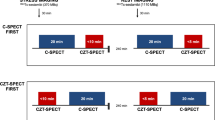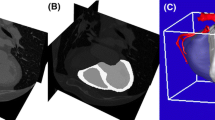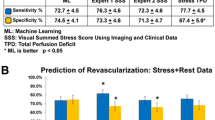Abstract
To explore the feasibility and efficacy of radiomics with left ventricular tomograms obtained from D-SPECT myocardial perfusion imaging (MPI) for auxiliary diagnosis of myocardial ischemia in coronary artery disease (CAD). The images of 103 patients with CAD myocardial ischemia between September 2020 and April 2021 were retrospectively selected. After information desensitization processing, format conversion, annotation using the Labelme tool on an open-source platform, lesion classification, and establishment of a database, the images were cropped for analysis. The ResNet18 model was used to automate two steps (classification and segmentation) with five randomization, training and validation steps. The sensitivity, specificity, positive likelihood ratio, negative likelihood ratio, positive predictive value, negative predictive value, Youden’s index, agreement rate, and kappa value were calculated as evaluation indexes of the classification results for each training-validation step; then, receiver operating characteristics (ROC) curves were drawn, and the areas under the curve (AUCs) were calculated. The Dice coefficient, intersection over union, and Hausdorff distance were calculated as evaluation indexes of the segmentation results for each training-validation step; then, the predicted images were exported. Under the existing conditions, the radiomics model used in this study had an AUC above 0.95 in identifying the presence or absence of myocardial ischemia; in the prediction of the extent of myocardial ischemia, its evaluation index distribution is also close to that of the gold standard. Radiomics can be feasibly applied to left ventricular tomograms obtained from D-SPECT MPI for auxiliary diagnosis. With more in-depth research and the development of technology, adding this method to the existing auxiliary diagnosis will likely further improve the diagnostic accuracy and efficiency, and patients will therefore benefit.




Similar content being viewed by others
Data availability
Available but to be used only for verification of this study and not for other purposes.
Code availability
Available but to be used only for verification of this study and not for other purposes.
References
Virani SS, Alonso A, Aparicio HJ et al (2021) Heart disease and stroke statistics-2021 update: a report from the American heart association. Circulation 143:e254–e743. https://doi.org/10.1161/cir.0000000000000950
The writing committee of the report on cardiovascular health and diseases in China (2020) Report on cardiovascular health and diseases in China 2019: an updated summary. Chin Circ J 35:833–854. https://doi.org/10.3969/j.issn.1000-3614.2020.09.001
The joint task force for guideline on the assessment and management of cardiovascular risk in china (2019) Guideline on the assessment and management of cardiovascular risk in China. Chin Circ J 34:4–28. https://doi.org/10.3969/j.issn.1000-3614.2019.01.002
Lima RSL, Peclat TR, Souza A, Nakamoto AMK, Neves FM, Souza VF, Glerian LB, De Lorenzo A (2017) Prognostic value of a faster, low-radiation myocardial perfusion SPECT protocol in a CZT camera. Int J Cardiovasc Imaging 33:2049–2056. https://doi.org/10.1007/s10554-017-1202-3
Nudi F, Iskandrian AE, Schillaci O, Peruzzi M, Frati G, Biondi-Zoccai G (2017) Diagnostic accuracy of myocardial perfusion imaging with CZT technology: systemic review and meta-analysis of comparison with invasive coronary angiography. JACC Cardiovasc Imaging 10:787–794. https://doi.org/10.1016/j.jcmg.2016.10.023
Cantoni V, Green R, Ricciardi C et al (2020) A machine learning-based approach to directly compare the diagnostic accuracy of myocardial perfusion imaging by conventional and cadmium-zinc telluride SPECT. J Nucl Cardiol. https://doi.org/10.1007/s12350-020-02187-0
Agostini D, Roule V, Nganoa C, Roth N, Baavour R, Parienti JJ, Beygui F, Manrique A (2018) First validation of myocardial flow reserve assessed by dynamic (99m)Tc-sestamibi CZT-SPECT camera: head to head comparison with (15)O-water PET and fractional flow reserve in patients with suspected coronary artery disease. The WATERDAY study. Eur J Nucl Med Mol Imaging 45:1079–1090. https://doi.org/10.1007/s00259-018-3958-7
Wu D, Wang L, Ma R, Fang W (2018) Technological advances and clinical application progress of the dedicated cardiac cadmium-zinc-telluride SPECT. Chin J Nucl Med Mol Imaging 38:564–567. https://doi.org/10.3760/cma.j.issn.2095-2848.2018.08.011
Lambin P, Rios-Velazquez E, Leijenaar R, Carvalho S, van Stiphout RG, Granton P, Zegers CM, Gillies R, Boellard R, Dekker A, Aerts HJ (2012) Radiomics: extracting more information from medical images using advanced feature analysis. Eur J Cancer 48:441–446. https://doi.org/10.1016/j.ejca.2011.11.036
Gillies RJ, Kinahan PE, Hricak H (2016) Radiomics: images are more than pictures, they are data. Radiology 278:563–577. https://doi.org/10.1148/radiol.2015151169
Wang JP, Fan X, Yu F (2021) Research status of radiomics in cardiovascular diseases diagnosis using nuclear medicine. Chin J Nucl Med Mol Imaging 4:370–373. https://doi.org/10.3760/cma.j.cn321828-20200311-00099
Slart R, Williams MC, Juarez-Orozco LE et al (2021) Position paper of the EACVI and EANM on artificial intelligence applications in multimodality cardiovascular imaging using SPECT/CT, PET/CT, and cardiac CT. Eur J Nucl Med Mol Imaging 48:1399–1413. https://doi.org/10.1007/s00259-021-05341-z
Juarez-Orozco LE, Martinez-Manzanera O, van der Zant FM, Knol RJJ, Knuuti J (2020) Deep learning in quantitative pet myocardial perfusion imaging: A study on cardiovascular event prediction. JACC Cardiovasc Imaging 13:180–182. https://doi.org/10.1016/j.jcmg.2019.08.009
Apostolopoulos ID, Apostolopoulos DI, Spyridonidis TI, Papathanasiou ND, Panayiotakis GS (2021) Multi-input deep learning approach for cardiovascular disease diagnosis using myocardial perfusion imaging and clinical data. Phys Med 84:168–177. https://doi.org/10.1016/j.ejmp.2021.04.011
Hu LH, Betancur J, Sharir T et al (2020) Machine learning predicts per-vessel early coronary revascularization after fast myocardial perfusion SPECT: results from multicentre REFINE SPECT registry. Eur Heart J Cardiovasc Imaging 21:549–559. https://doi.org/10.1093/ehjci/jez177
He K, Zhang X, Ren S, Sun J (2016) Deep residual learning for image recognition. In: 2016 IEEE conference on computer vision and pattern recognition (CVPR), IEEE, Las Vegas, NV, USA, pp 770–778
Chang Y, Yang H, Yao SL (2021) Comparative analysis of the accuracy of visual qualitative assessment and semi-quantitative analysis in 18F-florbetaben β-amyloid imaging. Chin J Nucl Med Mol Imaging 41:23–27. https://doi.org/10.3760/cma.j.cn321828-20200228-00078
Shibutani T, Nakajima K, Wakabayashi H, Mori H, Matsuo S, Yoneyama H, Konishi T, Okuda K, Onoguchi M, Kinuya S (2019) Accuracy of an artificial neural network for detecting a regional abnormality in myocardial perfusion SPECT. Ann Nucl Med 33:86–92. https://doi.org/10.1007/s12149-018-1306-4
Betancur J, Commandeur F, Motlagh M et al (2018) Deep learning for prediction of obstructive disease from fast myocardial perfusion spect: a multicenter study. JACC Cardiovasc Imaging 11:1654–1663. https://doi.org/10.1016/j.jcmg.2018.01.020
Betancur J, Otaki Y, Motwani M, Fish MB, Lemley M, Dey D, Gransar H, Tamarappoo B, Germano G, Sharir T, Berman DS, Slomka PJ (2018) Prognostic value of combined clinical and myocardial perfusion imaging data using machine learning. JACC Cardiovasc Imaging 11:1000–1009. https://doi.org/10.1016/j.jcmg.2017.07.024
Betancur J, Hu LH, Commandeur F et al (2019) Deep learning analysis of upright-supine high-efficiency SPECT myocardial perfusion imaging for prediction of obstructive coronary artery disease: a multicenter study. J Nucl Med 60:664–670. https://doi.org/10.2967/jnumed.118.213538
Arsanjani R, Dey D, Khachatryan T, Shalev A, Hayes SW, Fish M, Nakanishi R, Germano G, Berman DS, Slomka P (2015) Prediction of revascularization after myocardial perfusion SPECT by machine learning in a large population. J Nucl Cardiol 22:877–884. https://doi.org/10.1007/s12350-014-0027-x
Benjamins JW, Hendriks T, Knuuti J, Juarez-Orozco LE, van der Harst P (2019) A primer in artificial intelligence in cardiovascular medicine. Neth Heart J 27:392–402. https://doi.org/10.1007/s12471-019-1286-6
Juárez-Orozco L, Martinez Manzanera O, Storti A, Knuuti J (2019) Machine learning in the evaluation of myocardial ischemia through nuclear cardiology. Curr Cardiovasc Imaging Rep 12:5. https://doi.org/10.1007/s12410-019-9480-x
Koçak B, Durmaz E, Ateş E, Kılıçkesmez Ö (2019) Radiomics with artificial intelligence: a practical guide for beginners. Diagn Interv Radiol 25:485–495. https://doi.org/10.5152/dir.2019.19321
Acknowledgements
Not applicable.
Funding
This study was funded by the Clinical Research Plan of SHDC (No. SHDC2020CR4065).
Author information
Authors and Affiliations
Contributions
Wang designed the study, performed the experiments, analyzed the data, and wrote the manuscript. Zhang, Fan and Qin provided guidance on the experimental methods and writing of the paper in this study. Yu provided the final review and various supporting work for this study. Shi provides assistance and review during the revision of this article.
Corresponding authors
Ethics declarations
Conflict of interest
All authors declare that there are no conflict of interest.
Consent to participate
We used the image of the patient after information was hidden; this item is not applicable.
Consent for publication
We used the image of the patient after information was hidden; this item is not applicable.
Additional information
Publisher's Note
Springer Nature remains neutral with regard to jurisdictional claims in published maps and institutional affiliations.
Rights and permissions
About this article
Cite this article
Wang, J., Fan, X., Qin, S. et al. Exploration of the efficacy of radiomics applied to left ventricular tomograms obtained from D-SPECT MPI for the auxiliary diagnosis of myocardial ischemia in CAD. Int J Cardiovasc Imaging 38, 465–472 (2022). https://doi.org/10.1007/s10554-021-02413-x
Received:
Accepted:
Published:
Issue Date:
DOI: https://doi.org/10.1007/s10554-021-02413-x




